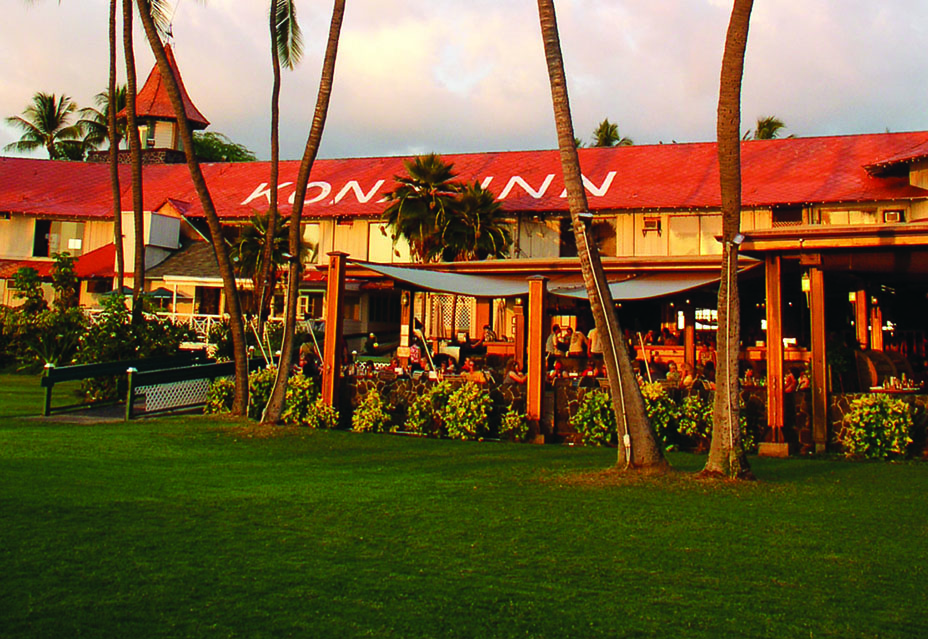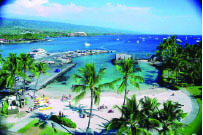
Then & Now: “Dillingham’s Folly,” or How the Railroad Came to Hawai‘i

By Ann C. Peterson
Imagine a time when the only way to get from the Hamakua district to Hilo and points south was by walking, by horse, or by “the most scenic railroad in the nation,” the Hawai’i Consolidated Railway—a railway whose history is as rich as the route was beautiful.
The railway was a testament to the vision of one man, Benjamin Franklin Dillingham, a Yankee who had found himself in Hawai‘i after many adventures and, as history records, many misadventures. Dillingham, born in West Brewster, Massachusetts in 1844 into a reputable Puritan family, dropped out of school at age 14 to pursue adventure as a sailor that included trips around Cape Horn and capture by the Confederate raider, the Alabama. While on shore leave on O‘ahu in 1865, he fell off a horse while riding, breaking his leg. His boat sailed off, leaving him in the hospital to mend and, during his long recovery, he began building a network of friends who induced him to stay in the islands. He soon secured a job in a hardware store, and within four years purchased the store in partnership with Alfred Castle, son of Samuel Castle, of Castle & Cooke, who financed the purchase. By 1889, Dillingham retired from the hardware business and put his full attention into a venture that was being called “Dillingham’s Folly.”
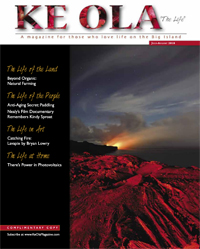
He had proposed irrigating 60,000 acres of O‘ahu ranch land, planting it with sugarcane, and transporting the tons of cane with a rail system. Railroads received early support from King Kalākaua, who in 1878 signed an act to promote their building in Hawai’i. Even with this level of support, it wasn’t until 11 years later, and with the backing of such notables as S.N. “Father” Castle that the first railroad excursion took place. On Sept. 4, 1889, Dillingham’s 45th birthday, the Oahu Railway & Land Co. ran from Honolulu to the rice fields of Palama one-half mile away.
The rail corridor quickly expanded to 160 miles through productive sugar and pineapple plantations, and Dillingham’s Folly became the single greatest factor in the development of O‘ahu and Honolulu during that era. With this success in place, he set his sights on duplicating the rail model on the islands of Kaua‘i, Mau‘i, and Hawai‘i.
On Hawai‘i Island, Dillingham began his venture with the purchase of acreage in what was then called Ola‘a—now Kea‘au—in the late 1890s, and began growing sugarcane. He received a charter to lay the first eight miles of track on March 28, 1899, and the route from Ola‘a to Waiakea was opened in 1900. A 17-mile extension to the Puna Sugar Company in Kapoho and the Pahoa Lumber Company, which was manufacturing ‘ōhia and koa railroad ties for export to the Santa Fe Railroad; two branches to other southern-based sugar plantations; and a link directly into Hilo quickly followed.
Branching out solely for tourists visiting the volcano, the next expansion connected Ola‘a to Glenwood, 12.5 miles up the mountain. One trip offered by the railroad carried intrepid visitors most of the way to Kilauea Volcano with food and entertainment and a night’s accommodation included. Visitors would travel from Hilo on rail, through Mountain View, but had to go the last eight miles by horse and wagon since the end of the rail line was in Glenwood. At this point, Hilo Railroad Company had become a thriving business, hauling tons of sugarcane and freight, and hundreds of passengers. It was the final 33.5-mile extension from Hilo up to Pa‘auilo, along the rugged Hamakua coast that took a bit of time, was much more expensive to build, and drastically changed the fortunes of Dillingham and other investors.
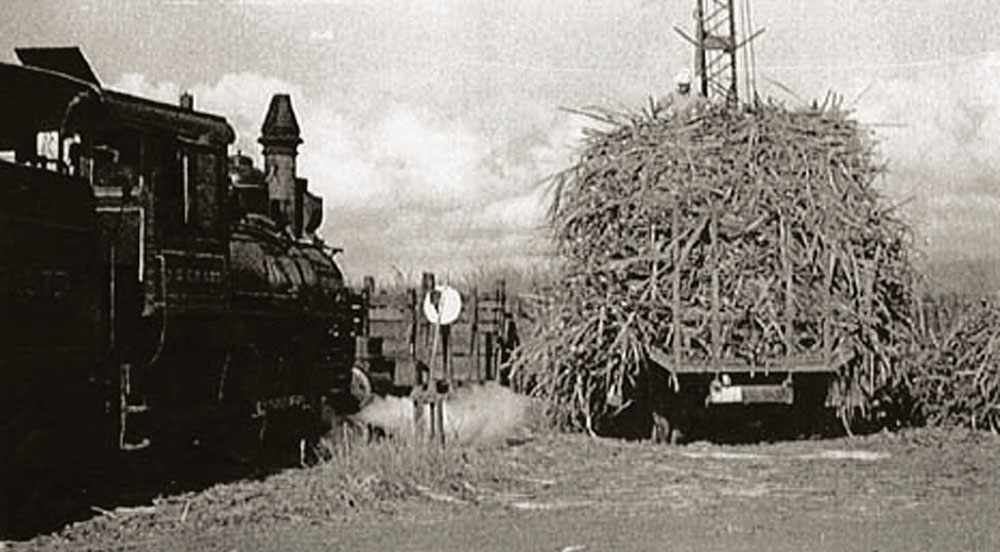
In negotiating a deal with Hawai‘i’s territorial government and the U.S. Congress in 1907 to build a breakwater in Hilo Bay and improve its harbor, Hilo Railroad agreed to connect Hilo with the lush sugarcane lands north to Pa‘auilo. Those of you who have driven along this coast can appreciate the barriers that engineers faced to create what was to be (at the time) the most expensive rail line, mile-for-mile, in the world.
Because of the rugged nature of the Hamakua Coast, the railway had to cross hundreds of streams and valleys. A combination of tunnels and distinctive curved trestles enabled the trains to negotiate the daunting topography. Dozens of steel trestles rose over 150 feet above the streams underneath them. Thirty-five trestles were built, crossing over 12,000 feet, with 211 water openings. Some of the individual steel spans were up to 1,006 feet long and 230 feet in height. At three enormous gulches, over 3,100 feet of tunnels were constructed, blasted through the lava rock hills. Most notable were those spanning the Maulua and Honoli‘i gulches, and the Wailuku River in Hilo. The Maulua Tunnel alone was over half a mile in length.
The resulting financial burden forced the company into receivership in 1914. Reincorporated as the Hawai’i Consolidated Railway, the line became very a popular passenger line with more than 600,000 annual trips. Folks visited family and friends, went shopping into Hilo, or just went sightseeing. Some students rode five days a week to classes in Hilo. Catering to popular demand, special excursions (including a delicious lunch featuring cow’s tongue) were run along the breakwater as it was being built.
Along with passenger trips, freight—particularly that hauled from the numerous sugar plantations along the line—helped move the company out of debt. During the war, troops on leave packed the passenger cars en route to Camp Tarawa in Waimea. Old-timers recall Marines passing meal rations through the train windows into the hands of local children, who eagerly exchanged them for guavas and mangoes.
Unfortunately, just as the company was beginning to recover, on April 1, 1946, a tsunami hit the windward side of the island, causing death and devastation—including the destruction of the bridge trestles at Wailuku and Kolekole. Much of the track near the Bayfront was uprooted and twisted, and train sections lay next to the wreckage of homes and businesses.
It was estimated that $500,000 in repairs would get the line running again. The outlying plantations encouraged reconstruction of the lines, but those located closer to Hilo, and no longer as dependent upon trains, successfully voted to close down the operation.
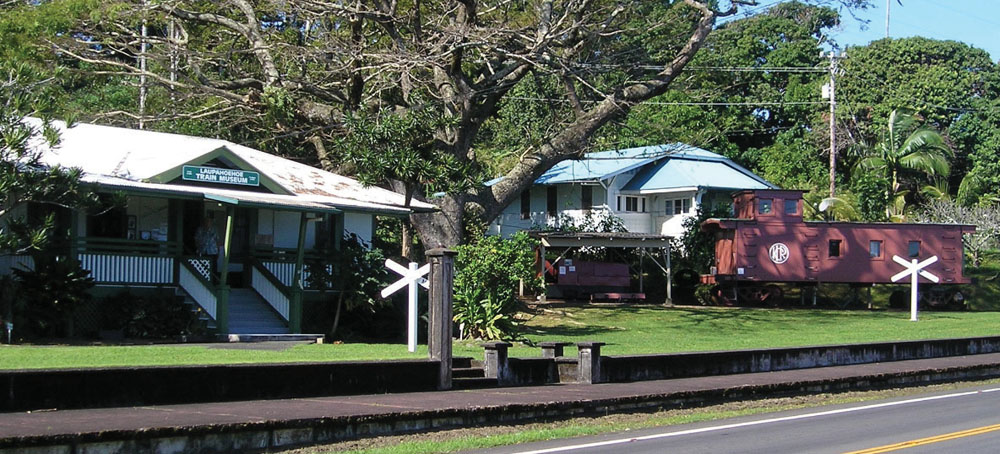
While this rich part of Hawai‘i Island’s history is sadly gone, there are still many remnants of this past transportation system to be found. A must see for all train and history enthusiasts is the Laupahoehoe Train Museum, right on Highway 19 in Laupahoehoe. The museum is in the old station agent’s house and is testament to community involvement.
Lisa Barton, the museum’s coordinator, credits community donations for the incredible collection of train memorabilia on display. Even as we stand admiring a display, a fellow from Kurtistown comes in to donate some books. “Surprises come very much like this,” she says with a smile, and refers to one of the old engine’s bells that a neighbor found and donated. Then there are the photographs–hundreds of them. And you have to see the 8-minute video that she and friend Ray-Jo Baker made.
The museum has in its collection a segment of track that was uncovered behind the house during community workdays, clearing years of overgrowth. They uncovered a switching stand where the trains were once turned around. The museum also has an engine that Richard Chong, of Hilo donated and a team of volunteers, including Lisa’s husband, Michael restored to running order. Michael also serves as engineer on the trains that run along the track for special events, and he spearheaded building a replica of a caboose that visitors can climb around in.
As Hawai‘i Island’s leading railroad history proponent, Lisa is advocating another train museum, this one located in Hilo, where there would be a larger potential audience. “The actual roundhouse where trains were reversed and stored is still standing. It is the perfect place for this museum,” she says. The eight-bay concrete roundhouse, built in 1921 next to the county swimming pool on Kalanikoa Street, is in desperate need of repair.
Other remnants of the railroad can be seen along its old route, which for the large part has become Highway 19. Two inverted trusses, that were once part of Wailuku River’s trestle, buttress the bridge over Kolekole gulch between Pepeekeo and Honomu. And, if you take the old Belt Highway down into Hakalau Gulch, look up to see how the old trestle was widened for two lanes of traffic.
The old railroad alignment through Puna remains fairly intact and is under consideration for a different mode, yet equally old form of transportation, bicycles. The creation of a share-use pathway would allow for an alternative to riding along Highway 130, also provide an evacuation route is ever needed, and perhaps allow one to harken back to the days before the advent of cars. ❖
Author’s note: I encourage all of you with Internet capabilities to follow this link to a short film made in 1916 of part of the ride from Hilo to Hamakua. It shows some of the spectacular scenery, a great view of the flumes that carried sugarcane, plantation shacks, the tunnels and trestles, and some brave local behavior where folks are sitting and standing on boards angled out from the trestles. One of my favorite scenes is of a train traveling along a wooden trestle followed in perfect cadence by a car. The song is pretty catchy, too. http://www.youtube.com/watch?v=YQSBOEbEqzU&feature= player_embedded

